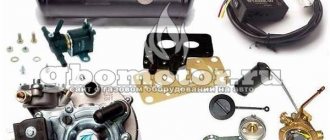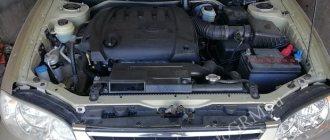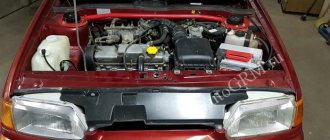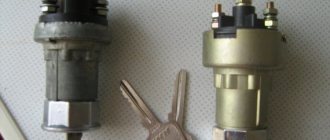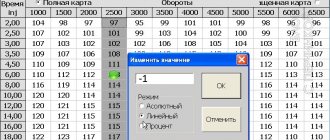A car subwoofer is an important element in complex speaker systems. In this case, it is important not only to select and connect the sub correctly, but also to configure it.
In practice, only after tincture does the subwoofer begin to produce the desired sound. Next, we will look at how the subwoofer settings are made, what parameters you need to pay attention to, and also how to configure the amplifier for the subwoofer.
Music for setup and testing
Regardless of what style of music will most often be listened to through the car's audio system, the subwoofer must be configured optimally for all areas that are characterized by a low frequency spectrum. It is divided into two types of low frequencies:
- useful lows - add richness;
- Parasitic lows are not perceptible to the human ear, but are felt on a physical level in the form of mild discomfort.
The setting involves precisely getting rid of or reducing parasitic lows, the frequency of which is from 30 to 40 Hz. They are mainly used in electronic music compositions and are a characteristic feature that should not be removed. Therefore, it is not advisable to use electronic music for tuning. The optimal material for testing would be to use compositions with classical instruments. This will allow you to compare the sound of familiar instruments and determine spurious sound frequencies, since bass lower than 30 Hz is rarely found in classical music.
There are also special programs for tuning speaker systems, tone generators that help configure a car subwoofer as accurately as possible by playing sound in a user-specified frequency range.
Bassboost
Bassboost - increases the volume at a certain frequency, usually 40-45 Hz.
When using a bass boost, the chance of burning the subwoofer increases sharply, since clipping occurs much earlier. In most cases, bassboost is not needed and if you are a beginner, then just accept the rule “Don’t touch bassboost!”
Experienced people can use it to increase the frequency response shelf in order to draw out dips in certain frequencies, but these are already deep settings and the effect does not always justify the risk.
First step: turning on the LPF filter
LPF (Low Pass Filter) is a low-pass filter that allows the speakers to play the bass specified during setup, while attenuating the presence of high sound frequencies. It can be located on the car's head unit or amplifier and is designated LPF or LP.
It must be turned on in the low frequency range 50-63 Hz. This parameter will be further adjusted after the settings of the remaining filters have been set. If the LPF filter is located both on the car radio panel and on the subwoofer amplifier, you only need to turn it on on one device. It would be rational to choose a radio, since adjustments on the amplifier are a little more difficult.
How to properly set up an amplifier in a car
Selecting the amplifier sensitivity level
Roughly speaking, volume (although this is not entirely true). By turning the knob from a larger number to a smaller one, we increase it.
Filters
LPF - filters out low frequencies.
HPF - filters out high frequencies.
Let's say, by setting the low-pass filter control to 50 Hz, the speaker will receive frequencies up to 50 Hz.
Attention: on different amplifiers, options are possible - either it will be a selector with a choice of filter type and one regulator, or separate regulators for the high-pass filter and low-pass filter.
In some amplifiers, it is possible to turn on both filters, so by turning on the low-pass filter and the high-pass filter, we can get a band-pass filter. For example, by setting the low-pass filter to 200 Hz and the high-pass filter to 50 Hz, the acoustics will reproduce a signal in the range from 50 to 200 Hz, respectively.
Some older amplifier models have fixed filters. Filtering is selected using the selector.
Subsonic
For the most part, it is necessary for subwoofers (in bass reflex design) But it can also be used as a high-pass filter.
There are also subsonics with a fixed filtering frequency.
Bass Boost
Allows you to increase the volume at a certain frequency.
Attention: the bass boost frequency is usually fixed. But some amplifiers have an additional regulator that allows you to select the required frequency.
There are also bass boosts with a fixed gain.
Phase regulator
Serves to coordinate the operation of the subwoofer with the front. And in general for more precise tuning.
There are also fixed phase controls.
Second step: adjusting the subwoofer speaker frequency
The frequency filter controls the subwoofer's playback frequency. It looks like a gear (phase shifter) with a hole for adjustment with a screwdriver in the center and is designated Subsonic. Adjusting this filter will remove low frequencies that are beyond the audibility range of the human ear and increase the service life of the subwoofer cone by preventing oscillations beyond the limits of capabilities. It is optimal to adjust the frequency five parameters lower than the standard bass reflex frequency of the subwoofer, which is indicated in its technical documents.
Third step: adjust output sensitivity
The output sensitivity adjustment filter also looks like a wheel for scrolling with a screwdriver and is designated “GAIN” or “LEVEL”.
There is a misconception that this parameter is responsible for the volume of the subwoofer, in fact this is not the case, even though when set to the upper positions the volume does increase. This filter is responsible for the coordinated operation of the head unit and subwoofer, and is configured using a specific method that has four simple steps:
- set the controls on the radio and amplifier to minimum and the sound signal will sound to check;
- the volume gradually increases until the first distortions in the sound appear, after which it returns to the last position at which there was a clear sound;
- then the regulator on the amplifier rotates upward until the first sound distortions appear;
- as soon as distortions appear, the regulator returns to the extreme position at which they did not exist.
Starting point for acoustic tuning
At the entry level, anything beyond adjusting crossovers and gain levels doesn't matter. In addition, it does not matter how the amplification part is implemented. The basic principle is always the same.
Here's how to set up the amplifier:
- To begin with, turn off any sound adjustment circuits.
- If this is not possible, then the correction is set to zero. It is worth remembering that this is not the same thing - in the first option, the signal will not go through the correction circuits. This means that its path will be shorter and the level of distortion will be lower.
- In passive crossovers, the RF control is set to approximately the average level, even if it is different from zero. You should select a value of -3 dB.
- In the case of active crossovers, the crossover frequency of the low-pass and high-pass filters is initially made the same. The level should be around 75-80 Hertz.
The gain level on any channels is set to the very minimum position. If all these conditions are met, then optimal basic settings can be achieved.
Fourth step: adjusting the acoustic phase
In order for the bass to sound in harmony with the other frequencies protruding from the front speakers and at the same time there is no perceived separation on the sides of the car, you need to correctly adjust the acoustic phase. This parameter is adjusted according to the driver’s personal feelings and is regulated by the Acoustic phase phase shifter, which is located on the front panel of the amplifier. You should gradually rotate the filter adjustment phase shifter clockwise until the front speakers and subwoofer begin to play in the same plane/acoustic phase (there will be no sensation of separate bass output from the rear). To check compositions, you need to listen to them in the driver's seat, where the sound separation is always more noticeable.
Watch the setup video:
Fifth step: adjusting the frequency junction
The final stage of setup is to adjust the sound of the midbass and subwoofer to a harmonious, comprehensive sound of music. During the preliminary setup, the LPF parameters were already set, which may have a difference with the low frequencies of the front speakers. Because of this, noticeable gaps may occur during playback. For example, if the LPF was set to 50 Hz, and the front speakers are running at 100 Hz, the sound will occur with a frequency dip in the range from 51 to 99 Hz. This does not mean that the filter will cut them off completely. It only smoothly reduces the sound of frequencies lying outside the specified parameter, and does not cut them out completely, but it is still too noticeable to the ear. To eliminate this effect, additional correction should be made using the LPF filter parameter. To do this you need:
- Play music rich in low frequencies through the speaker system.
- Turn the filter phase shifter several positions counterclockwise. This adjustment evens out the sound.
- If the dips are still noticeable. then the filter phase shifter rotates three phases in a clockwise direction.
Setting delays
The next step in setting up a subwoofer in a car is setting the delays. But this is only possible on a processor head unit or with an external processor. Some acoustic designs, such as FI, do not always have good impulse response, so the bass may be a little late. This is not always pleasant to hear.
For example, the front speakers played a note, and a split second later the sub played. To prevent this, the delays are adjusted, which allows the front speakers and subwoofer to play simultaneously.
Tips for setting up a subwoofer
- Haste and proper setup of the speaker system are incompatible things. You should set aside several hours of free time for high-quality setup.
- It is best to check the sound on known or favorite tracks, where you can definitely distinguish the correct sound from the distorted one.
- To check the tracks, you should listen to them with the doors and windows closed in the driver's seat, this way you can catch the slightest defects.
- Do not limit yourself to checking on one track; it would be best to carefully listen to several compositions of different genres and with a different set of sound frequencies.
- There are no specific parameters to which filter metrics need to be set. This article provides only the optimal and most popular parameter settings. It is necessary to configure based on personal taste preferences, monitoring the harmonious sound of the front midbass and subwoofer head.
By adjusting all the filters in this manner, you can achieve a loud subwoofer sound, while it will work harmoniously, without blocking the overall musical tone. This setting is suitable for all musical genres and will help expand the range of their sound.
Why do you need to set up a subwoofer?
First of all, tuning the acoustics is necessary to enhance the required frequencies and increase the “drive” of the music. Theoretically, this process can be avoided by using factory presets (i.e. settings). However, not everyone is satisfied with their quality. Firstly, the factory does not take into account the features of your car's interior. Secondly, equipment manufacturers are completely unaware of your musical preferences.
Many car owners believe that having a large and powerful subwoofer guarantees excellent music sound quality.

